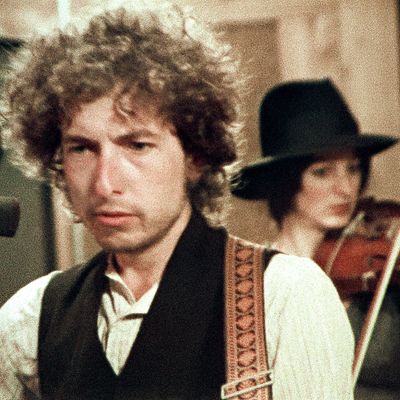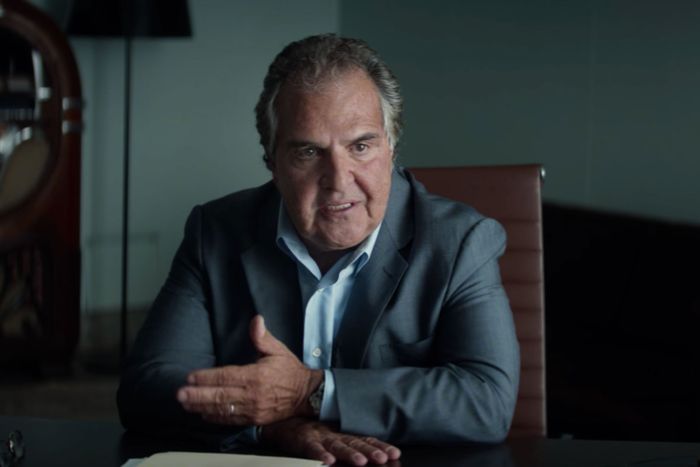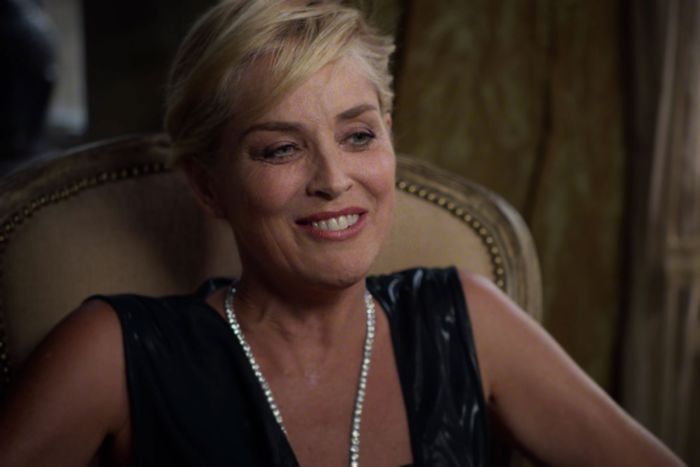
“When somebody’s wearing a mask, he’s gonna tell you the truth. When he’s not wearing a mask, it’s highly unlikely.” That’s one of the few-and-far-between lines uttered by Bob Dylan in Martin Scorsese’s just-released Netflix “documentary,” Rolling Thunder Revue: a Bob Dylan Story by Martin Scorsese. And it speaks volumes about the movie itself, described by Netflix as “part concert film, part fever dream” and an “alchemic mix of fact and fantasy.” Featuring archival footage from Dylan’s historic, ramshackle “Rolling Thunder Revue” tour in 1975–76, alongside real and fake interviews with Dylan and the many collaborators who supposedly made appearances at one or more of the tour’s 57 stops, Rolling Thunder Revue is a bit trickier than your average doc. It blends truth and falsehood seamlessly, to the point where many people watching, I’d wager, won’t be able to tell the difference between what’s real and what’s staged.
In a brief behind-the-scenes story published by Rolling Stone earlier this week, a source close to the Netflix project told writer Andy Greene that the doc will intrigue the kinds of Dylan obsessives who desire (pun very much intended) to dig out some of its more factual material. However, Rolling Thunder Revue runs a hefty 142 minutes, coming in at about an hour shorter than Scorsese’s canonical 2005 Dylan picture, No Direction Home. It’s a run time that makes the multiple viewings necessary for a proper investigation a daunting endeavor.
So, with those fans in mind who have better things to do than pore over Scorsese’s Easter eggs, we’ve compiled a complete-as-possible compendium of what’s fictional in Rolling Thunder Revue — not so much to spoil the mystery but to potentially shield casual observers from unintentionally passing off historical falsehoods in the future. (After all, isn’t fake news our greatest enemy these days?) And if more of Scorsese’s historically fluid approach to studying Dylan is decoded in the weeks to come, trust that we’ll be updating this article to reflect that.
Stefan Van Dorp doesn’t actually exist …
Early on in Rolling Thunder Revue, we’re introduced to Stefan Van Dorp, a European documentarian who was allegedly involved in making countercultural short films (including The American Presidents and Burning Like a Silver Flame, the latter in collaboration with psych band Shocking Blue of “Venus” fame). We’re told he tagged along on the historic “Rolling Thunder Revue” tour after meeting Dylan at Allen Ginsberg’s apartment. “I wanted to show musicians making music together and working together,” he claims, later opining that his aim was to capture “the counterpoint between the excesses of the people of the tour and the disillusionment of society.”
Lofty goals, but just one problem: In Rolling Thunder Revue, Van Dorp is actually portrayed by Bette Midler’s husband, Martin Von Haselberg, a performance artist who’s been up to pranksterish happenings since he and his late professional partner Brian Routh formed the Kipper Kids in the 1970s. The doc goes to great lengths to establish Van Dorp as a real-deal figure in Dylan’s orbit. We’re meant to believe that Van Dorp enlisted playwright Sam Shepard to join Dylan’s tour, and that Van Dorp grew paranoid along the way — at one point, he was concerned that his hotel room was bugged (presumably by former Byrds front man and Dylan sideman Roger McGuinn). In reality, there was no Van Dorp, though Shepard was on tour. He was approached by Dylan to co-write the screenplay for the ill-fated 1978 film Renaldo and Clara, which was shot concurrently with the tour. (Shepard’s four-hour-long movie only made it into a select number of theaters and was never released on DVD or streaming platforms.)
… and neither does Rep. Jack Tanner.
In the back half of Rolling Thunder Revue, U.S. Representative Jack Tanner gives a testimonial claiming to have attended one of the tour’s concerts on behalf of future president Jimmy Carter. Eagle-eyed film buffs might recognize Jack Tanner — not because he also moonlighted as a movie star, but because he is also a fictional character portrayed by actor Michael Murphy, reprising the Jack Tanner character from Robert Altman’s Garry Trudeau–penned miniseries Tanner ‘88 from, uh, 1988. (If you’re a present-day comedy nut, you might also recognize him from his riotous brief turn as a white-supremacist patriarch in David Wain’s 2014 rom-com send-up They Came Together.)
Jim Gianopulos had nothing to do with the tour.
Another talking head featured in Rolling Thunder Revue is Jim Gianopulos, who claims to have booked the tour and habitually weighs on its financial viability and behind-the-scenes complications. Unlike Van Dorp, Gianopulos is a real person — specifically, the current CEO of Paramount Pictures; he just had zero involvement in the “Rolling Thunder Revue.” In a slight wink and a nod toward this untruth, Gianopulos mentions longtime Dylan friend Louie Kemp in one of his interviews, noting that he acted as a promoter on the tour, with right-hand man Barry Imhoff helping him out. In reality, Kemp has at times been referred to as the tour manager, with Imhoff handling promotional duties.
This is the type of minor historical obfuscation Dylan became known for. As Vulture’s Craig Jenkins points out, “Dylan got spooked at the end of the ’60s, anointed as a hero and poked and prodded for details about his life and history when what he appeared to want was, to quote the man himself, to be ‘a complete unknown.’”
Sharon Stone didn’t go on tour with Dylan …
One of Rolling Thunder Revue’s more bizarre “revelations” is that a 19-year-old Sharon Stone caught Dylan’s eye and was subsequently asked to join him and the musicians on tour, at one point even being asked to iron a shirt for Joan Baez. One problem with this account: Stone would’ve technically been 17 at the time, and Rolling Stone has confirmed that the photos of her and Dylan from the time are well-doctored fabrications.
… and, for that matter, Dylan’s whiteface stage makeup probably wasn’t inspired by KISS.
A detail from Stone’s fake tale is that she was wearing a KISS shirt when she met Dylan. The rockers’ makeup goes on to play a role of sorts in Rolling Thunder Revue. Dylan claims that violinist Scarlet Rivera — who was allegedly dating front man Gene Simmons at the time of the tour — took him to see the band in Queens (an area, as Rolling Stone also points out, the band hadn’t played in several years) and subsequently inspired him to adopt his own face-paint approach to “Rolling Thunder Revue” performances. Other possible influences include: Kabuki, David Bowie’s glam-rock getup, and the French film Children of Paradise from 1945, footage of which inspired Renaldo and Clara’s Renaldo and is incorporated in Rolling Thunder Revue.
In the end, even the origin of the tour’s name is questionable.
Early on in the doc, Larry “Ratso” Sloman — one of the many performers who joined Dylan on the tour — claimed that Dylan told him he was going to call the tour “Montezuma’s Revue” but was inspired to call it “Rolling Thunder Revue” after hearing literal thunder in the sky. In the second half of Rolling Thunder Revue, however, Dylan himself suggests that the tour’s name came from the honorific of Chief Rolling Thunder, which late spiritual leader John Pope christened himself as. So who knows! A similar who-can-say-really moment emerges when Dylan repeats his sometimes-stated claim that Desire’s “One More Cup of Coffee” was inspired in 1974 by witnessing the annual Romani pilgrimage in France; some have suggested the song was actually written at Greenwich Village club the Other End the following year.





